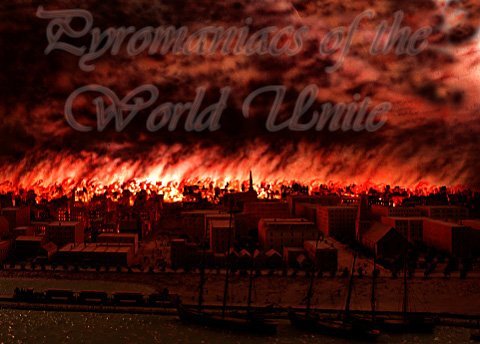
Fire is a fascinating endeavor that has remained the central theme of awe in the lives of many. Some people live for the sole purpose of witnessing the warm glazes that leave a feeling of deep satisfaction as some kind of matter is being destroyed. No matter how beautiful an object may be when it is being burned, it can never compare to the sumptle blazes that generate such supreme beauty. In order to fully appreciate the effects of fire, you must first understand it.
WHAT IS FIRE? No doubt fire is beautiful, but it goes far beyond external elegance. Burning, combustion, or oxidation are all terms referring to fire. Fire is the light one sees and the heat one feels when a substance is burning. A burning substance occurs as a result of rapid union of oxygen with other substances. Oxygen is constatnly uniting with other substances, but it's at such a slow rate that no heat and light are given off.
 KINDS OF FIRE. Fire flames occur at different colors depending upon the kind of material being burned and the temperature of the fire. Substances burn in different ways, but they all require oxygen to burn. Spontaneous combustion occurs when oxidation gradually takes place and enough heat accumulates to start a fire.
KINDS OF FIRE. Fire flames occur at different colors depending upon the kind of material being burned and the temperature of the fire. Substances burn in different ways, but they all require oxygen to burn. Spontaneous combustion occurs when oxidation gradually takes place and enough heat accumulates to start a fire.
Explosions can occur when there is very rapid burning like the kind that is produced by gunpowder and dynamite. Great volumes of gases are produced when this rapid burning takes place. It requires hundreds of times the space formerly occupied. These gases expand so rapidly and violently that they produce an explosion.
HOW FIRE IS PRODUCED. There are three conditions that must exist before a fire can occur. The first thing is a fuel or substance that will burn. The fuel can be a solid, liquid, or a gas. The second thing is that the fuel must be heated to its kindling temperature. The third thing that is needed is oxygen.
WHAT FIRE PRODUCES. An entire amount of a substance will not burn because the ask present in the fuel will not unite with oxygen. Substances that burn in air are almost always composed of carbon and hydrogen. Many fuels such as gas and fuel oils consist of carbon and hydrogen. When these burn, oxygen unties with the carbon and hydrogen to form carbon dioxide and water vapor. This uniting is what produces the heat and flames of the fire. The light of fires result from two different ways: The first way is that carbon particles in the flame become so hot that they give off light energy. The second way is that the burning gas is a type that gives off light.
Now that you understand the nature of fire, light away!

